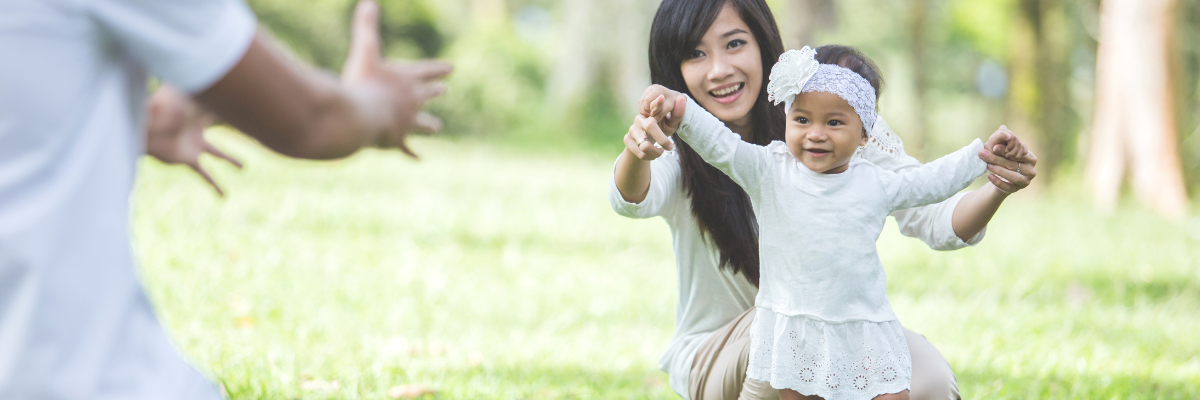Concerns About Your Child’s Ability to Walk
Are you concerned that your child hasn’t started walking yet? Development and achievement of motor milestones happens at a pace unique to each child. However, if your child has not yet started walking independently by 18 months it may be time to reach out to your local Physical Therapist for an evaluation. The Centers for Disease Control and Prevention (CDC) acknowledges that these walking-related physical milestones are typically met by age 1:
- pulling up to stand
- walking while holding on to furniture
- may be taking a few independent steps
- standing holding on and may stand alone
Delayed walking can occur for a variety of reasons – core weakness, lower extremity weakness, vestibular dysfunction, gravitational sensitivities, impairments in the motor plan or coordination for walking, and balance deficits to name a few. During a Physical Therapy evaluation we will assess your child’s strength, movement of their extremities and trunk, and balance. We will also screen for any neurological and vestibular concerns, as well as keep an eye out for any sensory involvement or gravitational sensitivities.
How can you begin helping your child learn to walk?
Here are some activity ideas that may be used by your Physical Therapist and that you can try at home to jump start those unsupported steps and help your child walk:
-
- Activities to promote weight shifting between lower extremities, as well as single leg stance balance needed for unsupported walking. Cruising laterally (side to side), across corners, around corners, and pivoting between surfaces. This can be done at a horizontal surface (i.e. coffee table or couch) or a vertical surface (wall, window, mirror, etc.). As your child masters pivoting between two surfaces, increase the distance between the surfaces to promote unsupported standing and stepping to reach the other side.
- While standing supported at the couch, coffee table, wall, window, etc. offload one of your child’s lower extremities. You can prop their foot on a pillow, stool, etc. or simply hold their foot up off the ground. As your child masters this while standing supported, try while they are standing unsupported and interacting with a toy with both hands. Shift their weight over one leg while stabilizing their knee on that side. Lift their other leg to prop on a stool, pillow, your leg, or simply hold their foot off the ground.
- Supported walking for increased duration and distance. You can start by having your child walk while holding your hands. Progress them from holding 2 hands to just holding 1 hand. Move from holding hands up, overhead to holding hands, forearms, or elbows at shoulder height. They can also engage in supportive walking using a walker/push-toy. Note: Always provide supervision when having your child use a push walker/toy. It is recommended to only use push toys and NOT a walker that your baby has to be physically placed inside of.
- Walking while standing in a small hula hoop/ring to promote reduced support and more variable support. Have your child hold on to the ring with both hands while you support the front or back of the ring. As they master this, wean away your support.
- Walking while holding a toy (ring, action figure, etc.) to promote walking with less support and eventually no support. Walk with your child while holding the toy together. As your child’s confidence increases, wean away your hold on the toy to promote walking with less support.
- Supported walking with a rubber band or hair tie to promote walking with more variable support. If your child will maintain a grasp on a rubber band or hair tie, try walking with them while holding the rubber band or hair tie together.
- Supported walking (hand hold or upper extremity support on a wall) while stepping over uneven surfaces (i.e. a pillow of blankets, couch cushions, pillows, etc.).
- Initiating unsupported stepping. Situate your child in standing with their back against the wall. Stand in front of your child and hold out an incentivizing toy, food, etc. to promote weight shift forward away from the wall, transition into unsupported standing, and progression to unsupported steps forward to reach you.
How can Carolina Therapy Connection help your child learn to walk?
Pediatric physical therapy promotes independence, increases participation, facilitates motor development and function, improves strength and endurance, enhances learning opportunities, and eases challenges with daily caregiving. When developmental progress is brought into question, it can be difficult for a parent. We know there is nothing as stressful as seeing other children advance quicker than your child, leaving them left behind as they develop at a slower pace than expected. It is important to understand that slower does not mean never! In fact, there are many late walkers who are able to overcome the delay and catch up with other children their age without concern.
If you have concerns about your child’s ability to walk, motor development or anything else, call Carolina Therapy Connection at 252-341-9944 or email us at info@carolinatherapyconnection.com to get started today! We accept all major insurances and would love to help your family and kiddo maximize their independence and potential to grow healthy and strong!
Blog Written By: Joann Flaherty, PT, DPT



